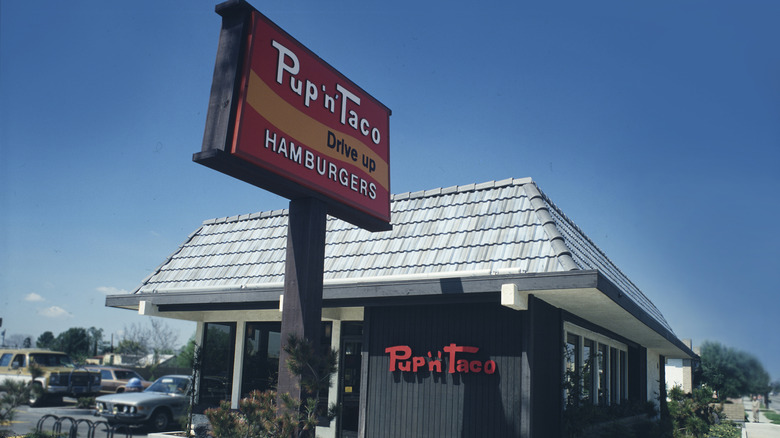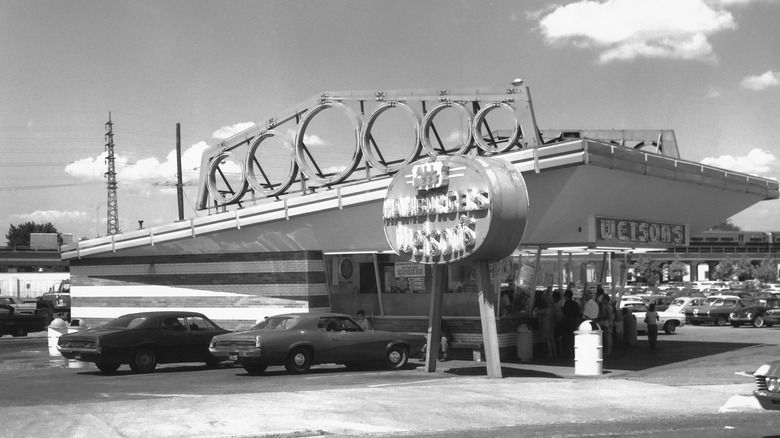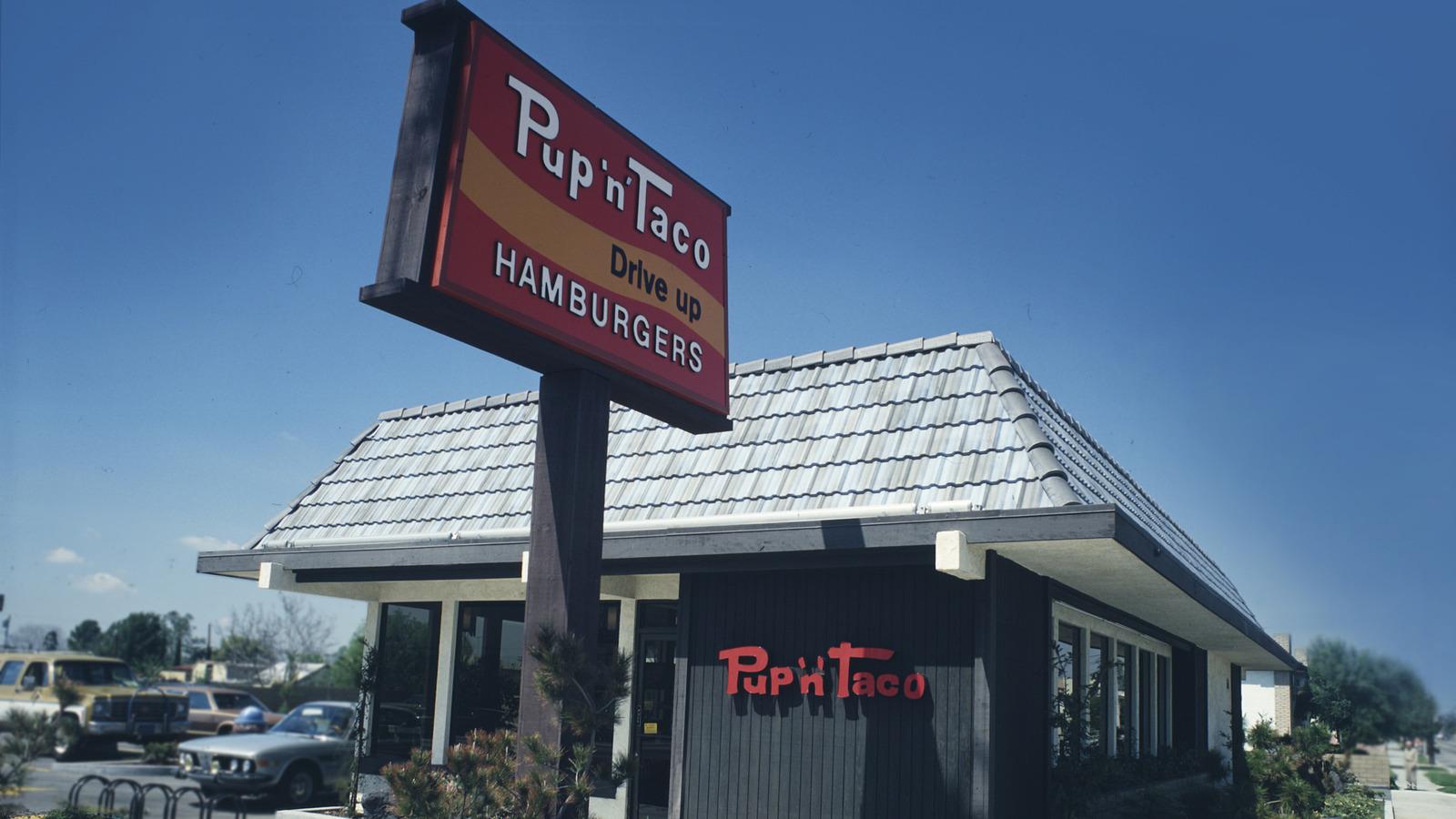
Tom Kelley/Getty Images
In the 20th century, American chain restaurants in America significantly shaped popular culture. Many chains that started up in the early to middle part of the 1900s hit their stride in the '70s, yet time wasn't gracious to all of them. Similarly, many restaurants that were born in the '70s and expanded into chains have since gone under. Many of these chain restaurants that have gone out of business were loved by many, which begs the question: why did they disappear?
Sometimes popularity isn't enough. The bigger a chain gets, the more high stakes the business becomes. A lot of restaurant chains rely on the franchise model to maximize expansion and profits. Franchising means involving a lot of outside parties into the operation. Professional relations between CEOs and franchisees can get messy — old-school chains like Friendly's almost went out of business due to franchise drama.
If you weren't around in the 1970s, you may have never even heard of some of the chain restaurants on this list. Yet to many who do remember eating at these chains, this will stir up nostalgic memories. Their sad disappearance reminds us of how challenging it is for old-school restaurants to keep up with our rapidly changing times.
Wag's
Long before Walgreens' financial struggles resulted in a nearly $10 billion buyout, the national drugstore chain was the founder of Wag's, a diner-style eatery that had a moment in the '70s. At the turn of the century, lunch counters at Woolworth's and other drugstores were common, but that wasn't what Walgreens had in mind. Wag's was a 24-hour restaurant chain that bore a closer resemblance to Denny's than a retro soda fountain.
Wag's became a destination for affordable late-night eats and breakfast classics like French toast and pancakes. Unlike the in-store lunch counters of other drugstores, Wag's 24-hours restaurants were freestanding locations apart from Walgreens. The chain's presence was concentrated in the Chicago metropolitan area and in Florida. There were also Wag's restaurants inside shopping malls, but they weren't open all night.
In 1988, Walgreens sold 91 Wag's locations to the Marriott Corporation, and the decision proved to be the beginning of the end. Two years later, Marriott offloaded all 29 Wag's locations in Illinois to the Lunan Corporation, which made no secret of its plan to convert them into Shoney's, a competing casual chain. Wag's restaurants in Florida fared no better. By 1991, Marriott closed the remaining Wag's still operating under its ownership. Many of the shuttered locations became IHOPs.
Burger Chef
For a while, Burger Chef seemed to be further ahead in the fast food game than its competitors — who may have borrowed a few of Burger Chef's branding ideas over the years. The first Burger Chef opened in Indianapolis, Indiana in 1957. The muse behind the restaurant was a flame broiler machine engineered by its co-owners, Robert Wildman, Donald Thomas, and Frank Thomas. The trio decided that the best way to showcase their new technology was by creating a burger restaurant.
Within two years, Burger Chef grew to over 40 restaurants. In 1964, it introduced the "Big Shef," a double burger with cheese, lettuce, sauce, and a hamburger bun between the patties. Burger Chef launched a kid-sized "Fun Meal" in 1973. Both ideas were adopted by a certain super-famous burger chain. Burger Chef spent much of the 1960s as the second most popular burger joint behind McDonald's.
On November 17, 1978, Burger Chef became infamous. Four night-shift employees, aged between 16 and 20, were abducted from a Burger Chef in Speedway, Illinois and murdered in the woods. The case was never solved. By the time Hardee's acquired Burger Chef in 1981, the chain's ownership had changed a few times over. For over a decade, Burger Chef locations were converted into Hardee's restaurants or closed. Burger Chef folded completely in 1996.
Lums
In 1956, the first Lum's (which launched with an apostrophe) restaurant opened in Miami Beach, Florida and got off to a strong start. Brothers Stuart and Clifford Perlman founded Lum's and relied on franchising to develop it into a chain with 450 restaurants. The Perlmans sold Lums in 1971 to focus on their new nest egg: Caesars Palace casinos. The '70s would be Lums' last good decade.
Lums was affordable, and just different enough to stand out from other casual family restaurants of the era. Hot dogs steamed in beer were an early hit at the chain, but the Ollieburger, a thick patty seasoned with 32 spices, that Lums served in the 1970s, turned out to be its greatest hit. Lums' second owner, John Y. Brown was responsible for bringing the Ollieburger to Lums. Brown, a wealthy politician, bought all 340 units of Lums for $4 million in cash and the secret Ollieburger recipe from Ollie Gleichenhaus, owner of a small hamburger restaurant in Miami Beach, for $1 million.
With Brown and the Ollieburger, Lums' future looked bright in the '70s, but in 1978, Lums was sold again, this time to Austrian restaurateur Freidrich Jan, who purchased IHOP in the same transaction. With Jan in the driver's seat, Lums filed for bankruptcy in 1982 and over the next several years Lums shuttered locations all over the place. The last Lums associated with the franchise was located in Bellevue, Nebraska. After 49 years in business, it closed in 2017.
Beefsteak Charlie's
The story of Beefsteak Charlie's is an interesting one. Beefsteak Charlie's was a New York City eatery started by Charles W. Chessar, who became known as Beefsteak Charlie. Chesser was a career restaurateur who found success with Beefsteak Charlie's in the 1930s and 1940s, then passed away in 1946. He left the Beefsteak Charlie's moniker copyright-free and it was swooped up, then eventually retired forever.
In the '70s, Larry Ellman, a restaurateur who had fallen on hard times, volleyed the reorganization of his chain Steak & Brew as an opportunity to reinvent. He began renaming former Steak & Brew locations as Beefsteak Charlie's, advertising it as an all-you-can eat buffet with all-you-can drink beer, wine, or sangria. Naturally, it gained a following.
Beefsteak Charlie's 2.0 flouted its affordability and excess through TV commercials that highlighted the simplistic joys of downing unlimited shrimp or meat with abandon (the free booze didn't hurt). In 1984, Beefsteak Charlie's reached its apex with 68 locations, but as time churned on, so did the chain's restaurant closures. By the early 2000s, the name Beefsteak Charlie's was a footnote of history.
Pup 'n' Taco
California has been home to lots of West Coast restaurant chains, including some that have disappeared. Pup 'n' Taco is one of the old-school chains that didn't make it. Pup 'n' Taco offered exactly what its name suggested: hot dogs, and tacos, plus a little more. Tostadas, burgers, french fries, and pastrami sandwiches were also menu highlights. Pup 'N' Taco got its start as a single hot dog and taco stand in Pasadena, California in 1965. Through the 1970s and into the 1980s, Pup 'N' Taco grew into a chain with almost 100 locations in Southern California. All of them disappeared.
Pup 'N' Taco's founder was Russell C. Wendell, a businessman who opened the Big Donut Drive-In in 1950 and developed it into a small chain in the Los Angeles area. Wendell later launched the taco drive-in, which segued into his opening of Pup 'N' Taco. A chain restaurant specializing in hot dogs, tacos, burgers, and pastrami sandwiches might seem disjointed, but stands selling burgers, tacos, and pastrami sandwiches are an L.A. tradition. Pup 'N' Taco's eclectic menu reflected the strong influence of Jewish, Mexican, and classic American cuisines in the city.
In 1984, Taco Bell, which had 1,800 locations at that time, was looking to make a deal with Pup 'N' Taco. As an early American chain, Pup 'N' Taco had something Taco Bell did not: prime L.A. real estate. Taco Bell purchased all 99 of Pup 'N' Taco's privately-owned locations.
Chicken George
Before Popeyes entered the scene, the Southern-style fast food segment had a worthy predecessor called Chicken George. Theodore "Ted" Holmes founded Chicken George in 1979, and in doing so he created a Baltimore relic that became Maryland's forgotten fried chicken chain. Before its extinction in the early '90s, it was the largest Black-owned fast food chain in the U.S.
Holmes' primary objective in creating Chicken George was to fill a hole in the fast food market. Up to that point, few chains were serving high-quality chicken in the style of soul food meals of the South. Holmes traveled across the U.S. sampling home-cooked chicken recipes and sides before filtering what he ate into Chicken George's earliest menus. The consumer response was so strong that Holmes worried he couldn't churn out Chicken George's products fast enough.
By the mid-1980s, competition from similar chains became overwhelming. Chicken George filed for bankruptcy in 1986. The chain never fully recovered from its public financial setbacks, and despite its former rapid expansion, wasn't able to hold on in the long run.
Winky's
Back in the day, Winky's had a hold on Pittsburgh and the Rust Belt region and beyond, amassing 40 locations across three states by the late 1970s. Winky's went into business as a single location in Sewickley, Pennsylvania in 1962. It was modeled after the great burger franchises of the mid-20th century, offering a burger counter and no in-house dining. There were affordable burgers and fries, and for the more adventurous eater, a hefty burger sandwich called "Big Wink." It's been said that the Big Wink inspired the creation of the McDonald's Big Mac. Eventually, Winky's added seating, and other items, including a breakfast menu.
Periods of economic recession in the '70s, made regional chains like Winky's vulnerable. National fast food chains with bigger budgets had a presence in Winky's territory (which spanned Western Pennsylvania, Eastern Ohio, and the Great Lakes area) were better-equipped to handle these volatile socioeconomic factors.
The quick-serve restaurant segment is a competitive market and Winky's financial setbacks soon became too much to endure. Winky's filed for Chapter 11 bankruptcy protection in 1982 and began closing unprofitable locations. In its 20th year in business Winky's ceased all operations.
Sandy's Drive-In
McDonald's expanding success in the 1950s was the golden standard for every businessperson hoping to cash in on America's burger craze. In 1956, four entrepreneurs in Illinois began franchising McDonald's locations of their own, only to find out that venturing into the cities of Decatur and Peoria was beyond what their contract with McDonald's allowed. Since they'd already tasted success in the fast food world, Gus "Brick" Lundberg, Robert C. Wenger, Paul White, and W. K. Davidson decided to further burgerize Illinois with a chain of their own. They called it Sandy's Drive-In, and it was a hit ... until it disappeared.
Sandy's founders needed an angle to differentiate it from McDonald's, so it chose to promote a Scottish motif. The restaurant's logo featured Sandy in a kilt, plaid socks, and gillies, yet the menu was the usual hamburgers, fries, and milkshakes. Sandy's franchise structure was perhaps its biggest departure from McDonald's. Franchisees were encouraged to own their restaurants rather than lease and weren't required to purchase supplies from the corporation as long as the food was up to the owners' standard.
Then, in 1971, Sandy's made a deal to merge with another enterprising burger chain, Hardee's. Despite initial assurances that the merger would leave existing Sandy's outposts intact, 90% of Sandy's locations became Hardee's by 1973. In 1979, the last Sandy's Drive-In was converted to Hardee's. Any independently-owned locations changed names to avoid legal infringement.
Wetson's

Camerique/Getty Images
In 1959, Wetson's was established in Levittown, New York, a suburban hamlet on Long Island. Its founders were Herbert, 21, and Errol Wetanson, 18. Herbert was inspired to open a hamburger restaurant after visiting a McDonald's in California. Wetson's sold hamburgers for 15 cents, fries for 10 cents. Its thick milkshakes were also popular. Wetson's rode this early success by opening more locations, but by 1975, the chain was gone.
Locations began popping up in Brooklyn, Queens, and Staten Island. The 1960s was a profitable decade for Wetson's. Its tasty food was an obvious selling point. At Wetson's height, the chain boasted 72 locations throughout New York, New Jersey, and Connecticut.
When McDonald's came to Manhattan in the early 1970s, Wetson's wasn't able to compete with its muse for very long. By 1975, Wetson's went from being the top hamburger chain in the region to nonexistent. After merging with fellow New York classic and legendary hot dog merchant Nathan's Famous, all of Wetson's locations closed.
Steve's Ice Cream
Ice cream harbinger Steve Herrell knows what it takes to make ice cream with an impact. Harrell was the man behind Steve's Ice Cream, a small '70s-era shop in the greater Boston area that was famous for its long lines and the delicious ice cream that waited on the other side. Steve's has been credited with being the first ice cream shop to advertise mixing crushed up candy bars into hard ice cream (called "mix-ins" or "smoosh-ins"). Since Dairy Queen's Blizzard didn't debut until 1985, long after Steve's was serving scoops, it seems plausible. Yet unlike Dairy Queen, Steve's Ice Cream isn't serving frozen treats anymore ... under that name at least.
In Davis Square, 5 miles outside of downtown Boston, Steve's Ice Cream made a name for itself as the new kid in town. Herrell worked alongside his staff, stood up to customers who acted unruly, and staved off the mounting advances of wealthy corporations that wanted to absorb what he had created. With mounting pressure to maximize the earning, Herrell sold his business to local competitor Joey Curgnale, CEO of Joey's ice cream and future founder of the Bertucci's chain.
Steve's Ice Cream disappeared so that Herrell's Ice Cream could endure. The small Massachusetts chain sticks to its roots while setting the quality standard for New England ice cream. Herrell's journey from namesake ice cream shop to modern day ice cream enterprise is proof that good businesses take time.
White Tower
Who stole what from whom is a popular topic amongst aged fast food chains, and for good reason. White Tower, a fast food chain that cropped up in the 1930s, was built on borrowed ideas. White Tower was founded in Milwaukee in 1926. White Castle — its most direct competition — was launched in Wichita, Kansas in 1921. White Tower's pure beef hamburgers sizzled profoundly in the 1930s, due to the company's expansion into 120 units. Before the chain disappeared, it was called out for being less than original.
The ordeal between White Tower versus White Castle was not unlike the way Barnes & Noble and Borders were positioned across the street from one another in hopes of drumming a speck of drama. White Castle took White Tower to court over how similar the pairs' brand messages and carved out castle façades were. The court ruled in White Castle's favor, and White Tower continued to struggle. As the 1970s churned on, White Tower closed more and more locations until there weren't any left.
VIP's
The ability to see a VIP's sign from the highway was basically the core of this bygone chain's business model — yet the simple strategy wasn't strong enough to last. VIP's got its start in Tualatin, Oregon in 1968. When founders Keith Andler and Robert Smith realized the second location in Salem, Oregon was less profitable due to being further away from the highway, they made sure that future VIP's locations wouldn't be far from off-ramps.
The 1970s was a time of expansion for VIP's, a chain that fell somewhere between a coffee shop and a diner. VIP's ambiguous yet approachable dining segment caught the attention of Denny's, a much larger chain that had perfected the art of serving coffee beside some short-order fare. In 1982, Denny's bought 35 of VIP's 53 locations for $12 million, with a provision that all current employees would retain their jobs. The sale prompted VIP's owners to sell off the remaining lot of its restaurants, resulting in the chain's complete disappearance in 1989.



